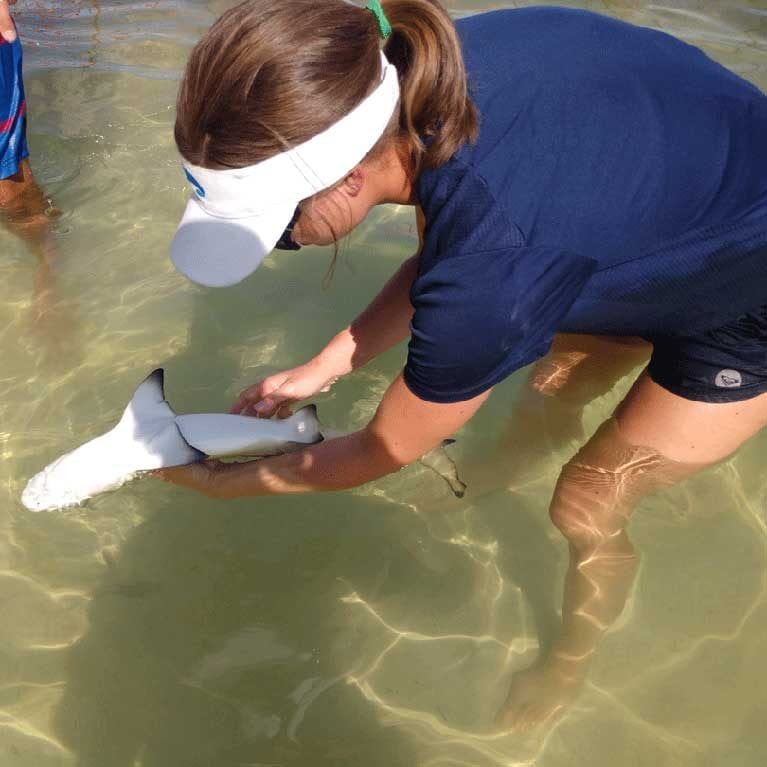Breaking ground with Bimini’s babies
What is pollution doing to sharks on a developed coastline in the Bahamas? Andria is using the latest in genetic analysis to understand its long-term impacts on lemon sharks.
As a kid, I loved the beach and going to it was always my favourite family vacation. But when episodes of Shark Week were aired, I never watched them, afraid that I wouldn’t want to get in the water if I knew what was down there. Eventually a friend got me to watch some shows and I was instantly in love. And so my obsession with sharks began. Today, as a PhD student at Florida International University, I am living the dream and doing research to help conserve these misunderstood and very important beasts of the sea.





Epigenetics as a new frontier to improve shark nursery conservation in Bimini (Bahamas)
Investigate how anthropogenic pollution triggers epigenetic responses facilitating shark responses to stress within and across generations. By elucidating how these marks are established and inherited, this work will be able to assess population health and define markers correlating to stressors, relatives, and nursery populations, helping assess long-term impacts of pollution.
One of the largest and best-studied lemon shark nurseries in the world occurs in Bimini,Bahamas. In the 2000s, construction began for a resort on North Bimini, during which time a large portion of the mangrove habitat was removed. It remains unknown how such disturbances affect sharks, hampering conservation efforts. More importantly, information about the impact of such stressors on future generations(i.e.,intra/trans-generational inheritance of stress-effects and/or acclimatization in offspring)is lacking. Our research aims to address these questions by incorporating epigenetics (the study of heritable changes in phenotypes without changes in genotype) into shark conservation and management. By characterizing the relationships between environmental stress,epigenetic modifications and phenotypic responses in lemon sharks from different nurseries, this work will be able to identify epigenetic markers for assessing population health in this species as well as in other Carcharhiniforms. Addressing these gaps in knowledge will give us proper tools to manage and conserve shark populations moving forward.
The district of Bimini, in the Bahamas, is home to one of the largest Lemon Shark (Negaprion brevirostris) nurseries in the world. Unfortunately, these nurseries have been heavily impacted by urban development for over a decade, especially in the North Sound (NS), where a major dredging event in the early 2000s impacted benthic and mangrove ecosystems, decreasing shark survival (Jennings et al., 2008). The recruitment of heavy metals and other pollutants into the water column stands as one of the most plausible hypotheses motivating such a population decline. These circumstances make this population an outstanding natural laboratory to study the effects of marine stressors on sharks. Top predators accumulate high concentrations of pollutants through bioaccumulation and biomagnification (Turoczy et al., 2000), making them ideal models for marine pollution monitoring (Vas, 1991). Additionally, Bimini nurseries have been monitored by the Bimini Shark Lab through annual samplings of individuals and reconstruction of pedigrees (family trees), revealing philopatric behavior by adult females (Feldheim et al., 2004; 2014) and high site fidelity in juveniles (Gruber et al., 2001). The sample archive spans two decades and includes samples collected before the major dredging event, facilitating the study of the effects of stress trans-generationally. Collectively, these resources provide a basis to develop environmental epigenetic analyses, elucidating how environmental stressors impact natural populations within and across generations. The present proposal aims to incorporate Epigenetics into shark conservation by analyzing temporal samples from sibling groups, evaluating cause-effect relationships between different environmental stressors and specific epigenetic marks (i.e., DNA methylation), as well as their inheritance and effects on phenotypes. Ultimately, this work will help develop new tools facilitating the assessment of shark population health and providing a basis for predicting the impact of stressors in future generations (more information in Beal et al., 2018).
- Characterize environmental parameters (i.e., salinity, turbidity, coastal development, etc.) and pollutant levels (i.e., trace heavy metals) found in both substrate and shark tissues across three nurseries (North sound (NS), Sharkland (SL), and South Bimini (SB)) differentially impacted by urban development in Bimini. **some environmental parameters have already been characterized.
- Use archived and newly collected samples of lemon shark individuals across those same nurseries to evaluate cause-effect correlations between environmental parameters and epigenetic marks (DNA methylation).
- Determine DNA methylation levels and patterns in lemon shark samples from the historic archive in order to trace their trans-generational inheritance at different geographical locations and their application in identifying subpopulations and making predictions of disturbance and environmental effects on populations into the future.

